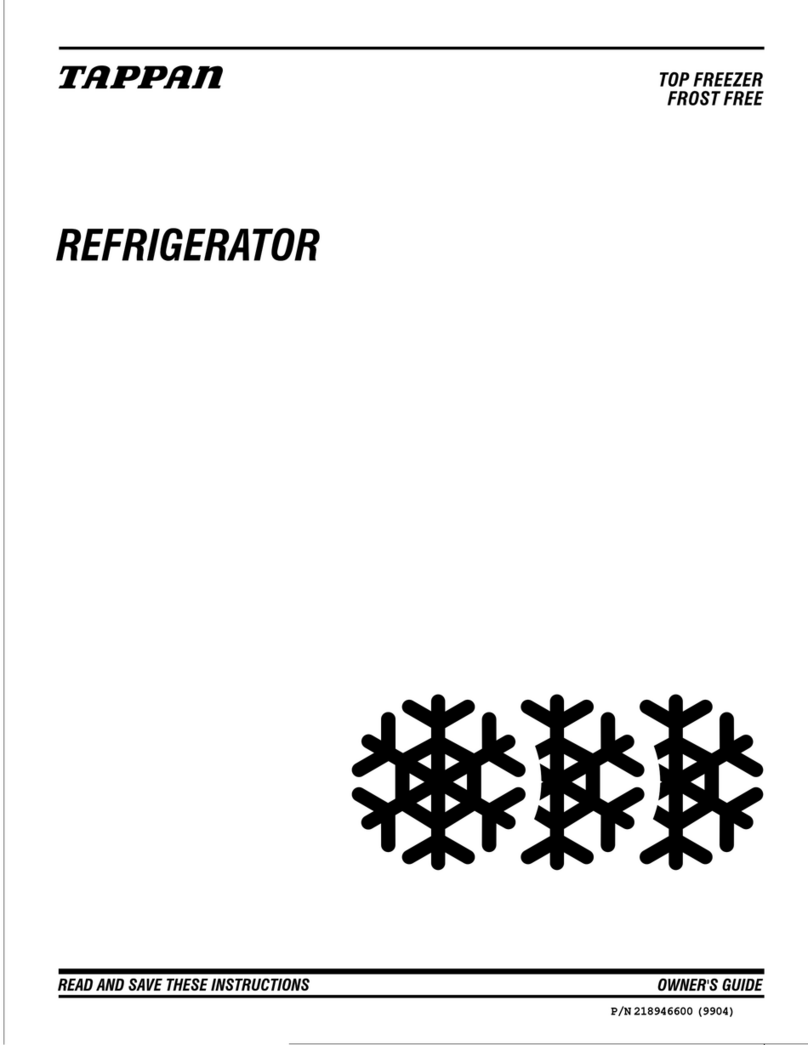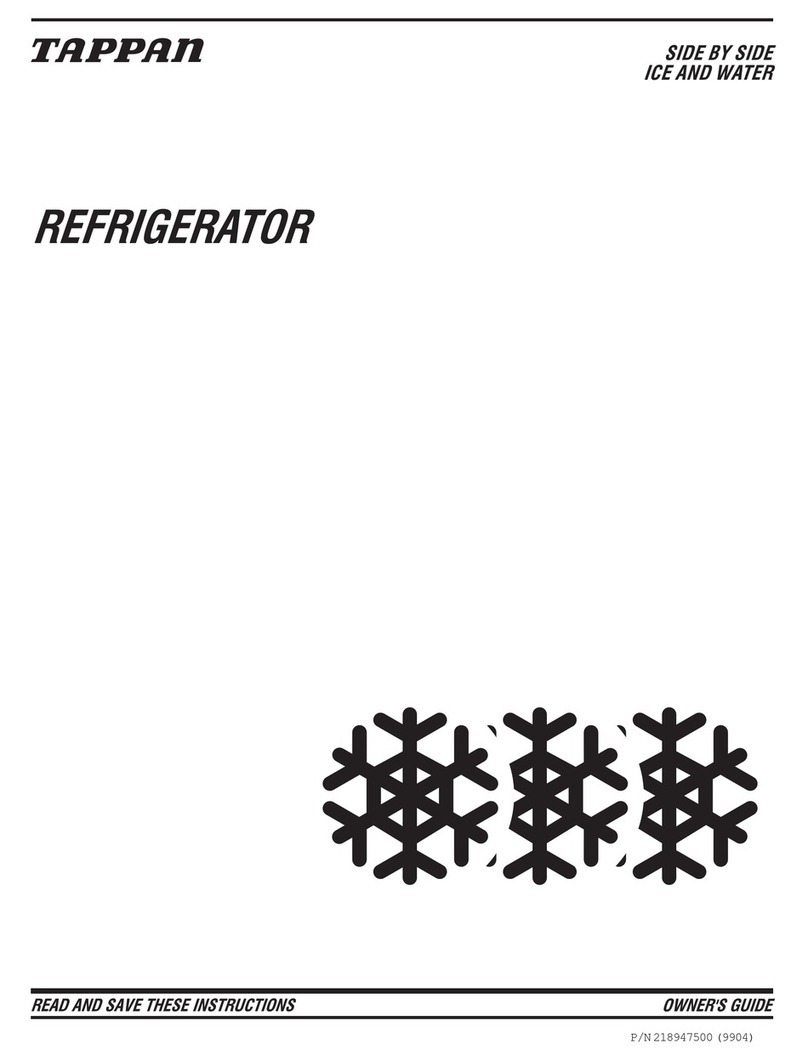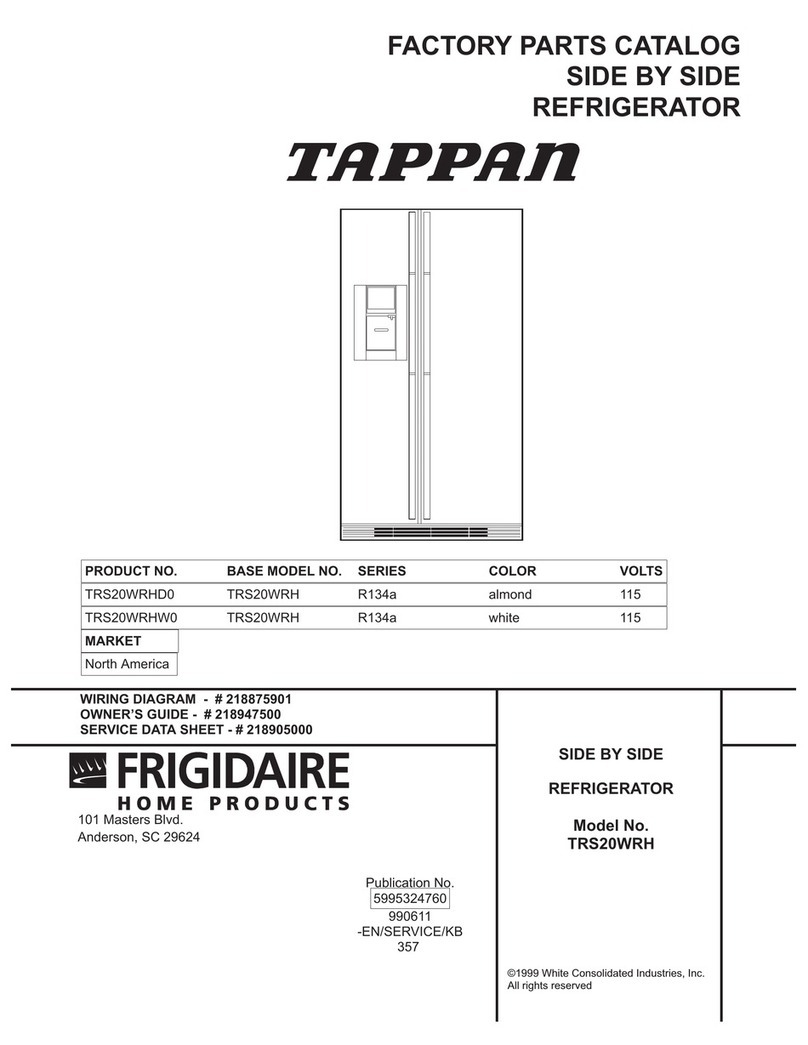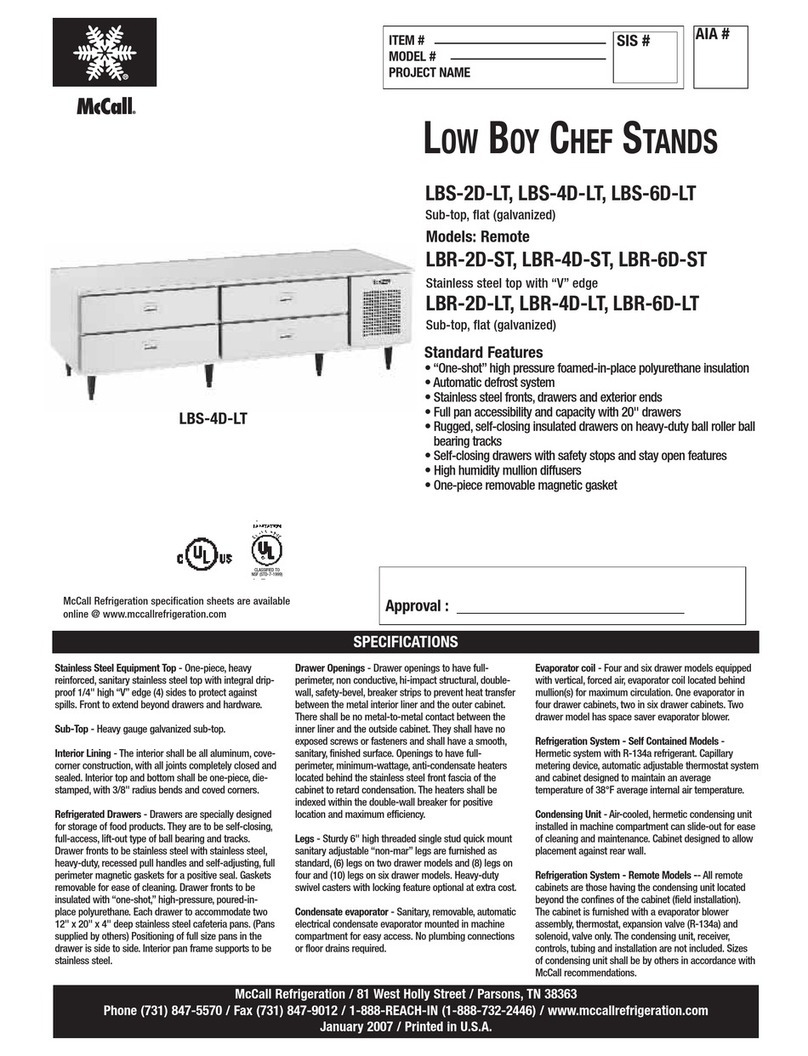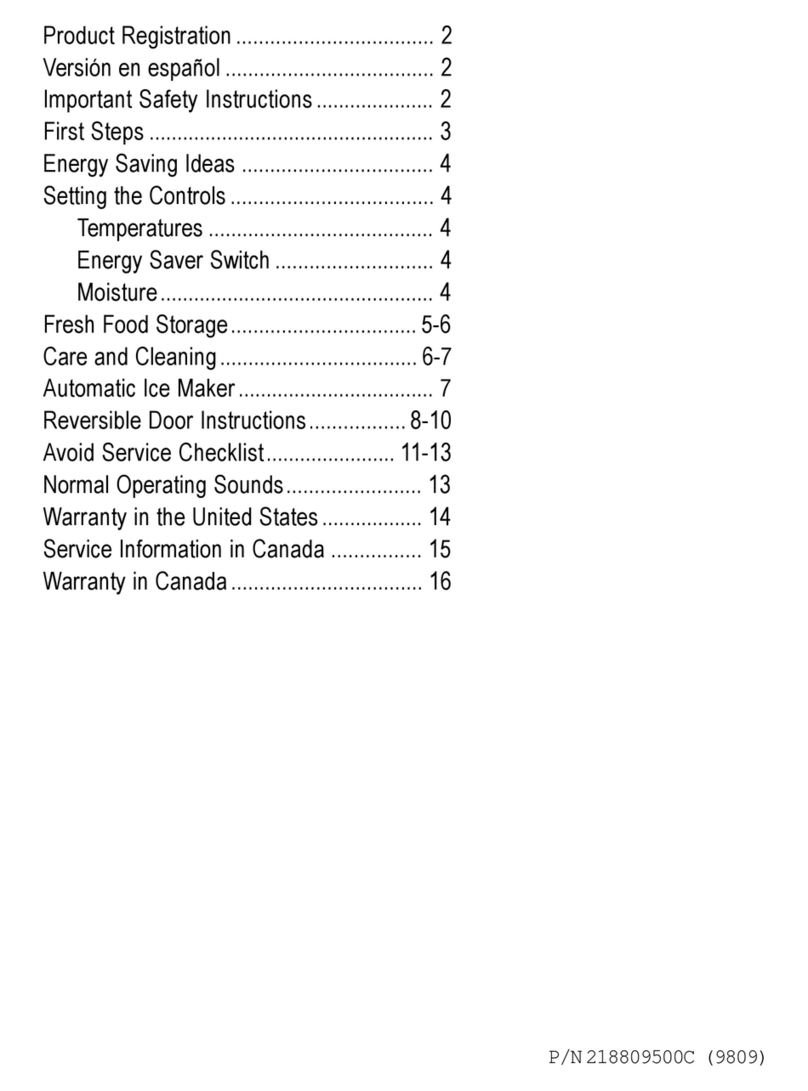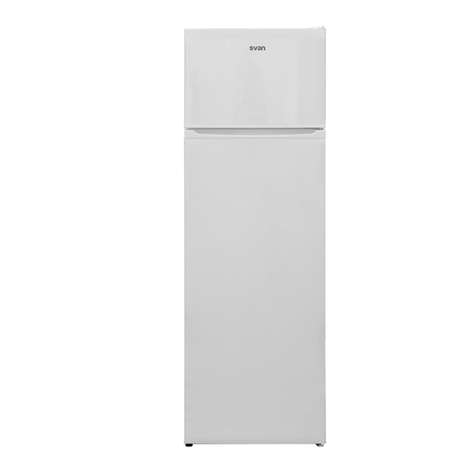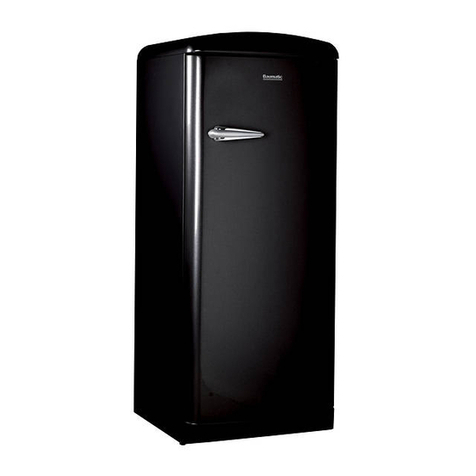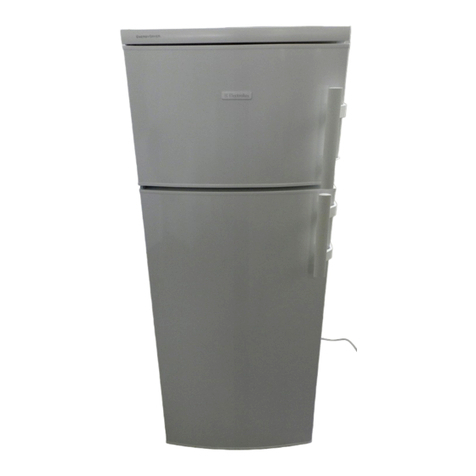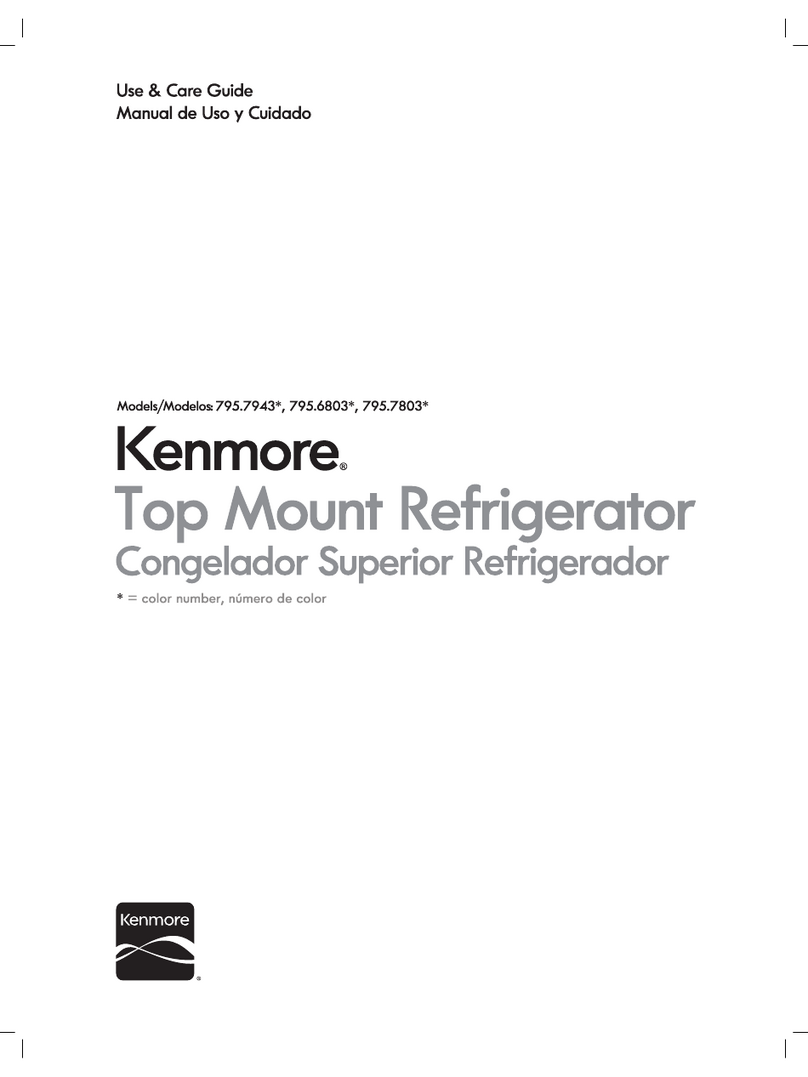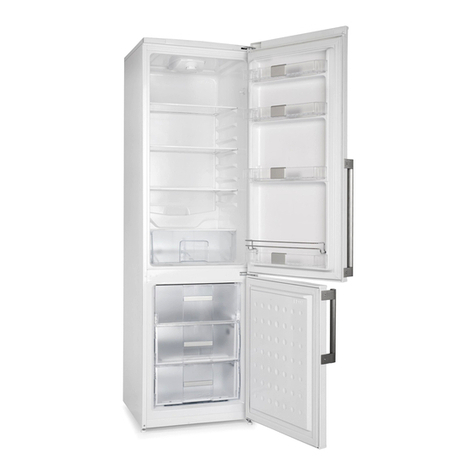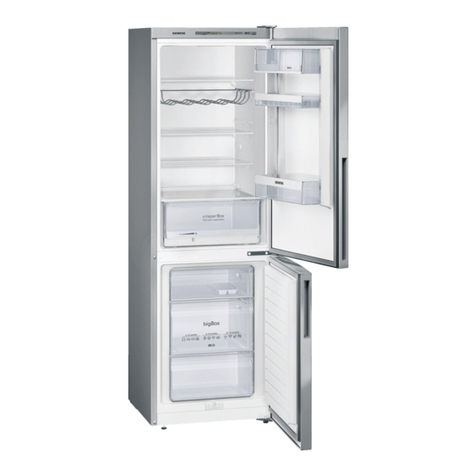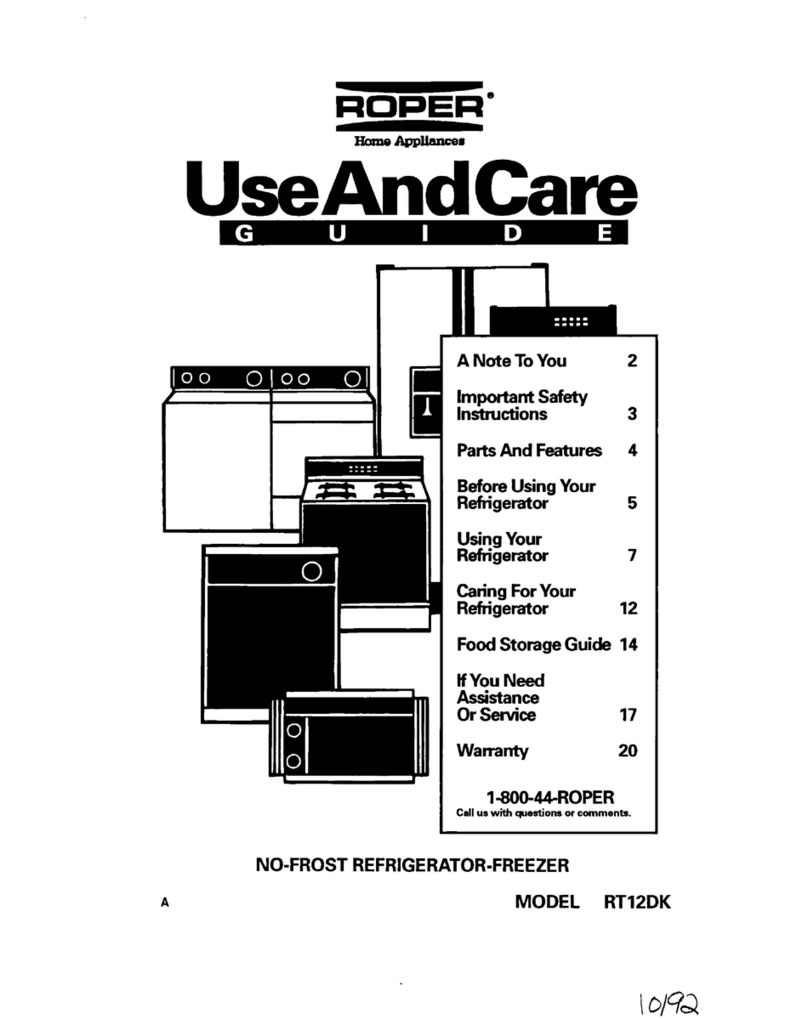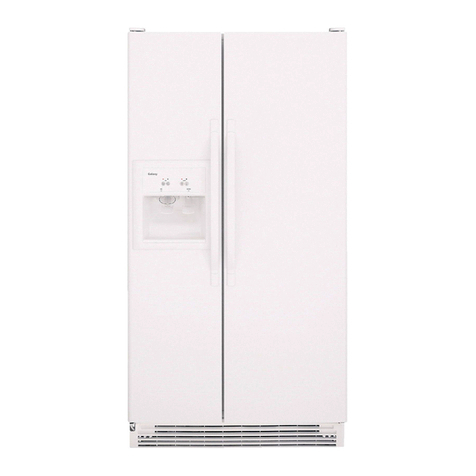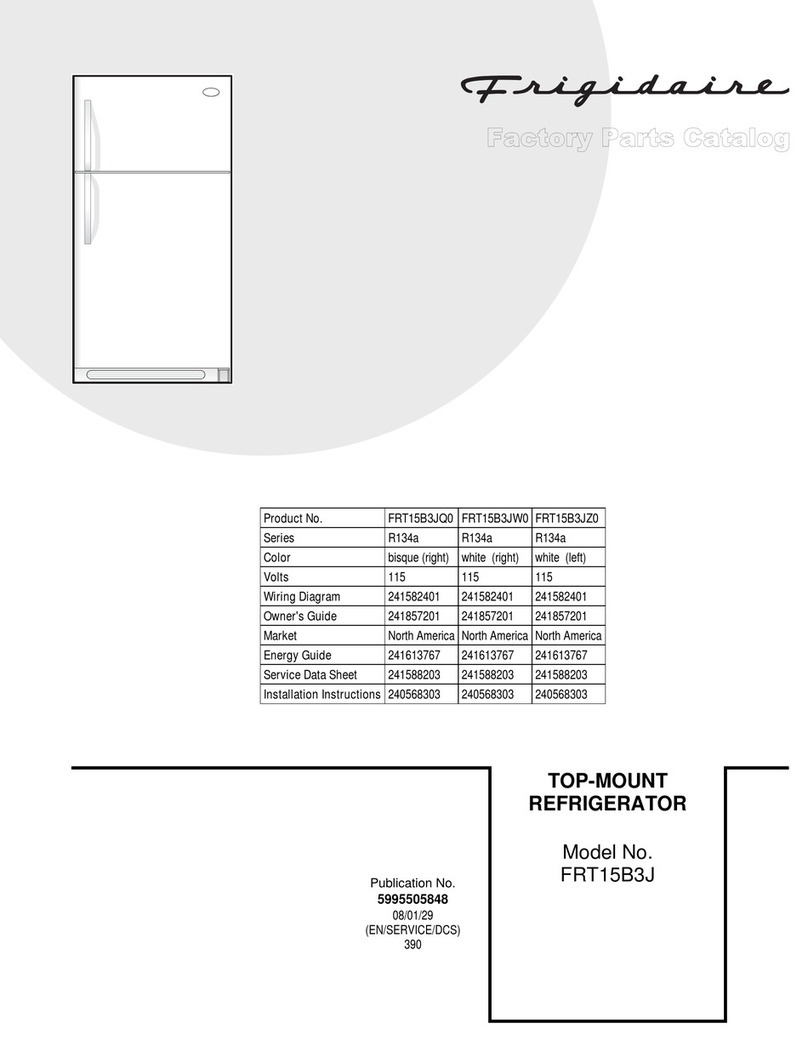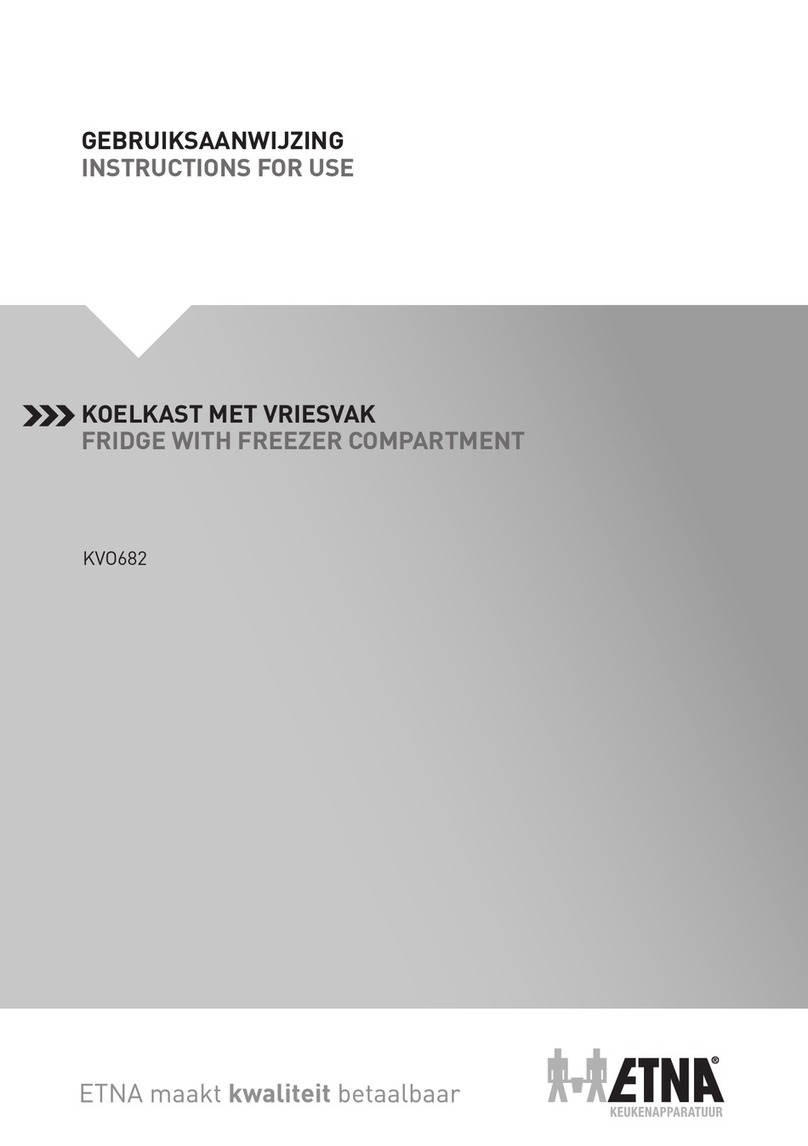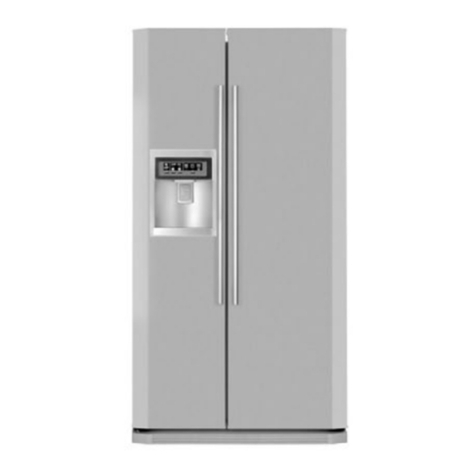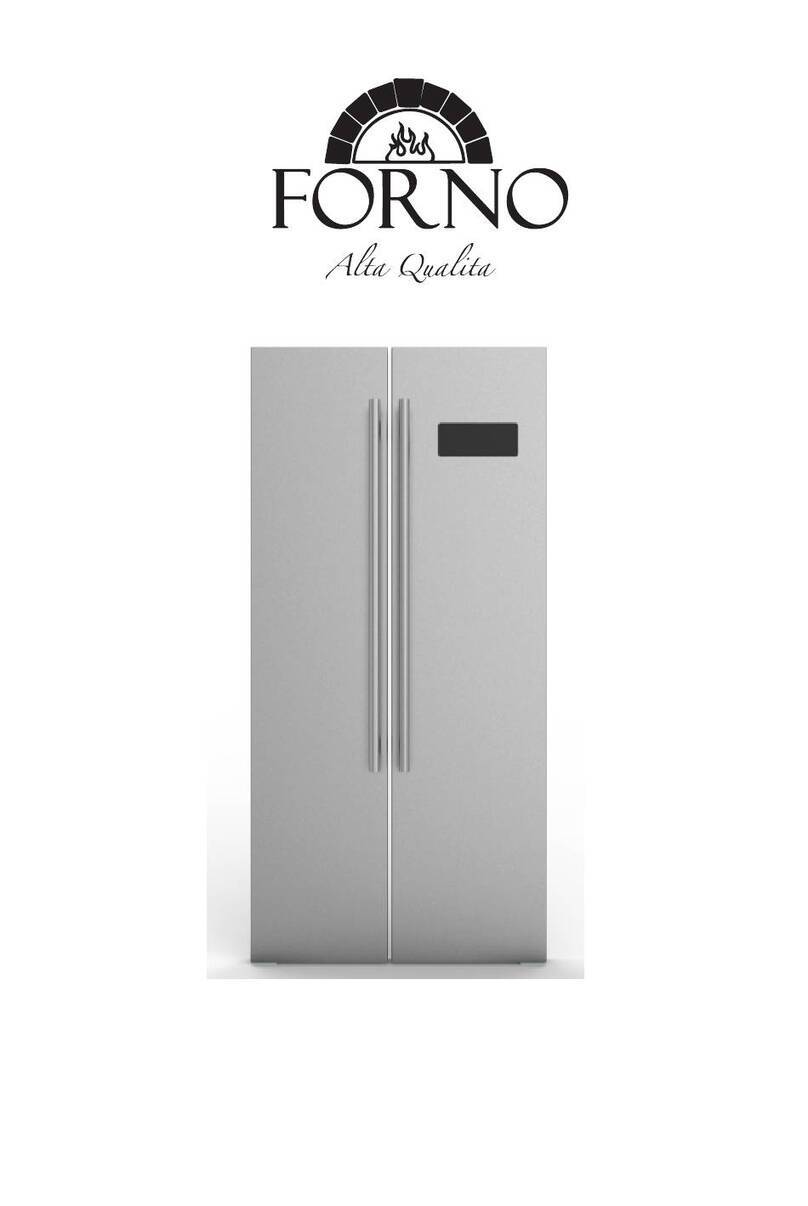Tappan TRS20WRHW5 User manual

P/N 218954501 (0101)

2
Product Registration The information contained in this Owner's Guide will instruct you on how to
properlyoperateandcareforyourproduct. Pleasereadthroughtheinformation
contained in your literature pack to learn more about your new appliance.
Record Your Model and Serial Numbers
Record the Model No. and Serial No. of this refrigerator in the spaces provided
below. These numbers are found on the serial plate located on the ceiling of the
refrigerator compartment.
Model No. __________________________________________________
Serial No. ___________________________________________________
Register Your Product
Theself-addressedPRODUCTREGISTRATIONCARDshouldbefilledincompletely,
signed and returned to the Electrolux Home Products.
2 ProductRegistration
3 ImportantSafetyInstructions
3 For Your Safety
3 Child Safety
3 ElectricalInformation
3 OtherPrecautions
4-5 First Steps
4 Location
4 Installation
4 Door Opening
4 Leveling
4 Cleaning
5 Connecting Ice Maker to Water Supply
6 EnergySavingIdeas
6 Setting the Controls
6 Cool Down Period
6 RefrigeratorControl
6 FreezerControl
7 Fresh Food Storage
8-9 Automatic Ice and Water Dispenser
10-11 Care and Cleaning
10 Inside
10 Outside
10 ReplacingtheLight Bulb
10-11 Vacation and Moving Tips
11-12 Removing the Handles and Doors
13-16 AvoidServiceChecklist
16 NormalOperatingSounds
17 Warranty
18 ServiceInformationCanada
Contents
© 2001 White Consolidated Industries, Inc.
All rights reserved.
Versión en español
Si desea obtener una copia en español de
este Manual del Usuario, sírvase escribir la
dirección que se incluye a continuación.
Solicite la P/N 218954600.
Spanish Owner's Guides
Electrolux Home Products
P.O. Box 212378
Augusta, GA 30917
This Owner's Guide provides specific
operating instructions for your model.
Use the refrigerator only as instructed in
this Owner's Guide.

3
Important Safety
Instructions For Your Safety
Do not store or use gasoline or other flammable vapors and liquids in the vicinity
of this, or any other appliance. Read product labels for flammability and other warnings.
• Destroy carton, plastic bags, and any exterior wrapping material immediately
after the refrigerator is unpacked. Children should never use these items for
play.Cartonscoveredwithrugs,bedspreads,plasticsheets,orstretchwrapmay
become airtight chambers that can quickly cause suffocation.
• Remove all staples from the carton. Staples can cause severe cuts, and ruin
finishes if they come in contact with other appliances or furniture.
• An empty, discarded ice box, refrigerator, or freezer is a very dangerous
attraction to children. Remove door of any appliance that is not in use,
even if it is being discarded.
Theseguidelinesmustbefollowedtoensurethatsafetymechanisms inthe
design of this refrigerator will operate properly.
•Refrigerator must be plugged into its own 115 Volt, 60 Hz, AC only
electrical outlet. The power cord of the appliance is equipped with a three-
prong grounding plug, for your protection against shock hazards. It must be
pluggeddirectlyintoaproperlygroundedthree-prongreceptacle.Thereceptacle
must be installed in accordance with local codes and ordinances. Consult a
qualified electrician. Do Not Use An Extension Cord Or An Adapter Plug.
• Ifvoltagevariesby10percent ormore,performanceofyourrefrigeratormaybe
affected. Operating the refrigerator with insufficient power can damage the
compressor. Such damage is not covered under your warranty. If you suspect
your voltage is high or low, consult your power company for testing.
• To prevent the refrigerator from being turned off accidentally, do not plug the
unit into an outlet controlled by a wall switch or pull cord.
• Do not pinch, knot, or bend the power cord in any manner.
Child Safety
Read all instructions before
using this refrigerator.
ElectricalInformation
• Neverunplugtherefrigeratorbypullingonthepowercord.Alwaysgriptheplug
firmly, and pull straight out from the receptacle.
• To avoid electrical shock, unplug the refrigerator before cleaning and before
replacingalightbulb. NOTE: Turning thecontroltoOFFturnsoffthe compressor,
butdoesnot disconnect power tothelightbulbor other electrical components.
• Do not operate the refrigerator in the presence of explosive fumes.
• Avoid contact with any moving parts of the automatic ice maker.
Other Precautions
Proper Disposal of Your
Refrigerator/Freezer
Risk of child entrapment.
Child entrapment and suffocation are
not problems of the past. Junked or
abandoned refrigerators are still
dangerous-eveniftheywillsitfor"just
a few days." If you are getting rid of
your old refrigerator, please follow
instructions below to help prevent
accidents.
BEFOREYOUTHROW
AWAY YOUR OLD
REFRIGERATOR OR
FREEZER:
• Take off doors.
• Leave shelves in
place, so children
may not easily
climb inside.
Avoid fire hazard or
electricshock.Donotuseanextension
cordoranadapterplug.Donotremove
anyprongfrom power cord.

4
First Steps This Owner’s Guide provides specific operating instructions for your model. Use
refrigeratoronlyasinstructedinthisOwner’sGuide. Beforestartingrefrigerator,
follow these important first steps:
Location
Install refrigerator:
• neara grounded electricaloutlet.DO NOT use anextensioncordor anadapterplug.
• outofdirectsunlightandawayfromrange,dishwasher,orotherheatsources,
if possible.
• onafloorthatislevelandstrongenoughtosupportafullyloadedrefrigerator.
• where a water supply is available for automatic ice maker.
Installation
• Do not install refrigerator where temperature will drop below 60°F (15°C), or
rise above 110°F (43°C). Compressor will not be able to maintain proper
temperatures.
• In a recessed installation, allow an extra 1/2 inch (10-15 mm) on each side for
ease of installation.
• If the hinge side of the unit will be placed against a wall, allow a 1-3/4 inch (44
mm) space between wall and refrigerator to permit proper door swing.
Door Opening
For best use of drawers and freezer basket, refrigerator should be in a position
where both the refrigerator and freezer doors can be opened about 135°.
Leveling
• Refrigerator must be leveled with all bottom corners resting firmly on a solid
floor. Adjust front rollers to level cabinet both front-to-rear and side-to-side.
Keepcabinet aslowas possibleforstability. Never adjustcabinetrollers sofront
is lower than rear.
•Toadjust frontrollers: Openrefrigeratorandfreezerdoors.Removetoegrille
by pulling it straight out. Adjust rollers by turning each roller adjusting bolt with
an adjustable wrench, a socket wrench, or a nutdriver until refrigerator is level
and stable. Rear rollers are not adjustable.
• Check both doors to be sure seals touch cabinet evenly on all four sides.
• Iffreezerdoorishigherthanrefrigeratordoor,raiserightcornerand/orlowerleft
corner until doors align across top of cabinet.
• Ifrefrigeratordoorishigherthanfreezerdoor,raiseleftcornerand/orlowerright
corner until doors align across top of cabinet.
•To replace toe grille: Line up tabs with holes, and push grille straight on.
Cleaning
• Wash the inside, all removable parts, and the outside with mild detergent and
warm water. Wipe dry. Do Not Use Harsh Cleaners On These Surfaces.
•Do Not use razor blades or other sharp instruments that can scratch appliance
surface, when removing adhesive labels. Any glue left from the tape or energy
labelcanberemovedwithamixtureofwarmwaterandmilddetergent,ortouch
glue with sticky side of tape already removed.
•Do Not Remove Serial Plate.
Adjusting Front Rollers
ROLLER ADJUSTING
BOLT
Replacing Toe Grille

5
First Steps
(continued) Connecting Ice Maker to Water Supply
Do Not Install Ice Maker Tubing Where Temperature May
Fall Below Freezing.
Check to be sure your water connection will comply with local plumbing codes.
Water quality determines your ice quality. It is best to connect the ice maker to
water that is not softened. Chemicals from a malfunctioning softener can
damage the ice maker. If the ice maker is connected to soft water, ensure that
the softener is maintained and working properly.
The ice maker requires a 1/4 inch (6.4 mm) copper water supply line (with
shutoff)fromyourhouseholdwatersystem.Allowenough tubing behind your
refrigeratorto permit moving out toclean floor.
Water line kit 5308950117 is available through your dealer at extra charge. This
kit includes 25 feet (7.6 meters) of 1/4 inch diameter copper tubing, plus parts to
connect to your cold water line, including a saddle valve assembly. You will need
to purchase a 1/4 inch brass compression nut and ferrule from your local hard-
wareorplumbing store.
1. Turn ON water supply and flush out copper tubing. Turn off water supply.
2. Unplugrefrigerator.
3. Install WATER SUPPLY LINE as follows (figure 2):
• Slide brass nut, then ferrule, onto copper tubing.
• Push end of copper tubing as far into the metal water valve fitting as it will
go (1/4 inch). Slide ferrule into fitting and thread brass nut onto inlet,
tightenfingertightplus 1/2 turn with wrench.
NOTE: Some models may have a cap on the valve. Unscrew the cap and
discard.
4. Secure copper tubing with STEEL CLAMP and screw to rear panel at location
shown (Figure 3).
5. Coil water supply tubing as shown (figure 3).
NOTE: To prevent vibration noise and wear, leave a space between all tubing
andothersurfaces.
6. Turn on water supply and check all connections for leaks (figure 3).
7. Plugrefrigerator cordinto walloutlet.
8. To begin ice production, lower the Wire Signal Arm to the “down” or “ON”
position(Figure 4).
IMPORTANT
Ice production will begin when freezer reaches normal operating temperature.
Air in new plumbing lines may cause ice maker to cycle two or three times
before making a full tray of ice.
New plumbing may cause ice to be discolored or have poor flavor. Discard ice
made during the first 24 hours. After installation, if you wish to shut the ice
maker off, lift the Wire Signal Arm until it clicks and locks in the “UP” position.
Figure1
Figure2
Figure3
Figure4

6
• Installtherefrigeratorinthemostcoolpartoftheroom,outofdirectsunlightand
away from heating ducts or registers. Do not place the refrigerator next to heat-
producing appliances such as a range, oven or dishwasher. If this is not possible,
asectionofcabinetryoranaddedlayerofinsulationbetweenthetwoappliances
will help the refrigerator operate more efficiently.
• Level the refrigerator so the doors close tightly.
• Refer to this Owner's Guide for the suggested refrigerator settings.
• Periodic cleaning of the condenser will help the refrigerator run more efficiently.
See Outside in the Care and Cleaning section.
• Do not overcrowd the refrigerator or block cold air vents. Doing so causes the
refrigeratorto run longer and usemore energy. Shelves shouldnot be lined with
aluminum foil, wax paper or paper toweling. Liners interfere with cold air
circulation, making the refrigerator less efficient, which could cause food
spoilage.
• Coverfoodsandwipecontainersdrybeforeplacingthemintherefrigerator.This
cuts down on moisture build-up inside the unit.
• Organize the refrigerator to reduce door openings. Remove as many items as
needed at one time and close the door as soon as possible.
Setting the Controls Cool Down Period
Toensuresafefoodstorage,allowtherefrigeratortooperatewiththedoorsclosed
for at least 8 to 12 hours before loading with food.
Refrigerator Control
• Therefrigeratorcontrolshouldbesetatthemidpointofthedialforatrialperiod
of 24 hours.
• After 24 hours, adjust the control as needed. For colder temperatures, turn the
dial a notch toward COLDEST. For warmer temperatures, turn the dial a notch
toward COLD. Adjust temperatures by one increment at a time.
Freezer Control
• The freezer control should be set at the midpoint of the dial for a trial period of
24 hours.
• After 24 hours, adjust the control as needed. For colder temperatures, turn the
dial a notch toward COLDEST. For warmer temperatures, turn the dial a notch
toward COLD. Adjust temperatures by one increment at a time.
NOTE: Whenfirstsettingthecontrolsorwhenchangingasetting,wait24hoursfor
the temperature to stabilize before making additional changes.
Turning the freezer control may change temperatures in both compartments. For
example,if thefreezercontrol isturnedtoacoldersetting,the refrigeratorcontrol
may have to be adjusted to a warmer one. Turning the refrigerator control will
change only the refrigerator temperature.
IMPORTANT: If the freezer control is turned to OFF, cooling stops in both
compartments.
You may hear the "Frost Free" system working. A fan circulates air in the
refrigerator and freezer compartments. For good circulation and maintenance of
proper cooling temperatures, do not block cold air vents with food items. Water
draining into the defrost water pan and hissing sounds are normal during the
automatic "Frost Free" cycle.
Energy Saving Ideas
Freezer Control
Refrigerator Control
Freezer Control

7
Fresh Food Storage Shelf Adjustment
Refrigerator shelves are easily adjusted to suit individual needs. Before adjusting
shelves,removeallfood.Theshippingclipswhichstabilizetheshelvesforshipping
may be removed and discarded.
To adjust the cantilever shelves (shelves supported at the rear of the refrigerator),
lift the back of the shelf up and out. Replace shelf by inserting hooks at rear into
slots. Lower and lock into position. Some models have Spillfree™ glass shelves,
which catch and hold accidental spills.
Door Storage
Doorbinsandshelvesareprovidedforconvenientstorageofjars,bottlesandcans.
Items used often are available for quick selection.
Thedoorbinscanbemovedtosuitindividualneeds.Removebinsbyliftingstraight
up. Place bins in the desired position and lower over the supports.
The Dairy compartment is warmer than the general food storage section and is
intended for short term storage of cheese, spreads, or butter.
Crisper
TheCrisperdrawer,locatedunderthebottomrefrigeratorshelf,isforstoringfruits
andvegetables.Mostproduceshouldbewashedinclearwateranddrainedbefore
placinginthisdrawer.Itemswithstrongodorsorhighmoistureshouldbewrapped
before storing.
The Humidity Control (some models) allows you to adjust the humidity within the
Crisperdrawer.Thiscanextendthelifeoffreshvegetableswhichkeepbestinhigh
humidity. Leafy vegetables, however, keep best when stored with the Humidity
Control set on HIGHER, or in a drawer without a Humidity Control. This keeps
incoming air to a minimum and maintains maximum moisture content.
Meat Keeper
The Meat Keeper is located at the bottom of the refrigerator. The temperature in
this compartment can be made colder than the rest of the refrigerator compart-
mentbysliding the Chilled Air Control knobwithintheCOLDESTor COLD range.
Meat will be partially frozen and may be kept fresh longer than if stored on a
refrigerator shelf.
BeforeplacingitemsintheMeatKeeper,followthesestepstokeepthemeatfresh:
1. Carefully handle meat with clean hands and always keep the compartment
clean.
2. Store meat in its original wrapper. If necessary, overwrap in plastic wrap or foil
to prevent drying. Wrap fish tightly to prevent odor transfer to other foods.
3. If spoilage ever occurs, disinfect the compartment with liquid chlorine bleach
followinglabel directions. Then rinsewith a solution ofbaking soda and water.
Rinse with clear water and dry.
Remove Shipping Clips
FRESH FRUITS & VEGETABLES
LOWER
FRUITS
HIGHER
HUMIDITY CONTROL
VEGETABLES
Humidity Control
Chilled Air Control Freezer Basket
A slide-out wire basket (some models have two) hangs below the bottom freezer
shelf. This basket provides easy access to frozen food packages.
Tall Storage Compartment(some models)
A shelf is attached to the freezer wall just below the ice server. This allows for
convenient storage of tall items placed vertically between the ice server and the
freezer wall.
Tall Storage
Compartment

8
Automatic Ice and
Water Dispenser Theiceandwaterdispenseronthefreezerdoorconvenientlydispenseschilledwater
and ice cubes.
To operate the dispenser, slide the knob to the selection of your choice and press
a glass against the dispensing arm, as shown. Be sure to hold the glass as far up as
possible to catch all ice. To stop dispensing, pull glass away from dispensing arm.
When dispensing ice, release the dispensing arm before the glass is full, but do not
remove the glass until the ice has completely dispensed.
A small heated area beneath the dispenser floor catches and evaporates small spills.
This drip tray is removable and dishwasher safe. Do not pour water or excess
cubes into this area because there is no drain.
Light
The dispenser has a light which can be turned on and off by sliding the knob to the
desired position. The light also turns on automatically when ice and/or water is
dispensed. Replace light bulb with an appliance bulb of the same wattage.
How the Water Dispenser Works
The water tank is located behind the drawers in the refrigerator compartment. As
thewaterisdispensed,thetankisautomaticallyrefilled.Forproperoperationofthe
dispenser, the supply water pressure must fall between 30 psi and 120 psi.
After the refrigerator is installed and the plumbing connections are complete, the
water tank should be filled by drawing one glass of water. It may take
about 1-1/2 minutes after depressing the dispenser arm before water works its
way through the plumbing connections and begins to fill this first glass. Draw and
discard7moreglassestobesurethatthetankandplumbingconnectionsarerinsed
of any impurities. The water delivery system has a built in shut off device that will
stop the water flow after 3 minutes of continuous use. Simply release the actuator
button to reset the dispensing mechanism.
To ensure fresh-tasting water, plan to use the dispenser every day. If the water
dispenser has not been used for a week or more, draw and discard 7-8 glasses to
freshen the tank supply.
How the Ice Dispenser Works
The ice maker and ice storage bin are located in the top left corner of the freezer
compartment. After the refrigerator is installed properly and has cooled for several
hours,the ice maker can begin making ice.Tobegin ice production, lower the wire
signalarmtothe "down"orONposition.As cubesaremade,theyare storedinthe
storagebin.Withnousageitwilltakeapproximately2daystofillthebin.However,
the dispenser may be used after the first batch of ice is made. The ice maker turns
off automatically when the ice storage bin is full.
Because of new plumbing connections, the first production of ice cubes may be
discolored or have an odd flavor. These should be discarded until the cubes made
are free of discoloration and taste. Remember that water quality
determines your ice quality. It is best to connect the ice maker to water that is not
softened. Chemicals from a malfunctioning softener can damage the ice maker.
If ice maker is connected to soft water, ensure the softener is maintained and
workingproperly.
To stop the ice maker, lift the wire signal arm until it clicks and locks in the "up"
or OFF position.
Dispenser Selector
Press glass against dispensing arm.

9
Do not use the ice
chute as a handle when removing
or replacing the ice storage bin.
Surfaces there may be sharp.
WARNING
Ice Dispenser Tips
1. Ice cubes stored too long may develop an odd flavor. Empty the container and
return it to the proper position. The ice maker will then produce more ice.
2. Occasionally shake the container to keep ice separated.
3. Ifthedispensingarmispushedinformorethan4minutes,thedispensermotor
may overload and stop. The overload protector will reset automatically after 3
or4 minutes. Ifalargequantity of iceisneededat one time,itisbest to remove
cubes directly from the ice storage bin.
4. Certain sounds are normal when the ice maker is operating. They are:
• Motor operation
• Ice being loosened from the tray
• Ice dropping into the storage bin
• Running water
• Water valve opening or closing
For more information on these operations, see NormalOperating Sounds.
5. Stop the ice maker when cleaning the freezer or for long vacations.
6. Iftheicemakeristobeturnedoffforalongperiodoftime,turnthewatersupply
valve to the closed position.
Automatic Ice and
Water Dispenser
(continued)
Cleaning the Ice Dispenser
Clean the dispenser and ice storage bin at regular intervals, particularly before you
take a vacation or move, or if the ice dispenser sticks.
1. Stop ice production by lifting the wire signal arm to the "up" or OFF position.
2. Remove ice storage bin by lifting up and out. Empty and carefully clean the bin
withmild detergent. Do not submerge the bin while cleaning. Rinsewith clear
water. Do not use harsh or abrasive cleaners. Allow ice bin to dry completely
before replacing in the freezer.
3. Remove ice chips and clean the shelf and chute that supports the ice storage
bin.
4. Replace the ice storage bin. Lower the wire signal arm on the ice maker to the
"down" or ON position and the ice maker will resume production.
IMPORTANT: Whenremovingorreplacingtheicebin,donotrotatetheaugerin
theicebin.Iftheaugerisaccidentallyturned,youmustrealigntheaugerbyturning
it in 90° turns until the ice bin fits into place with the drive mechanism. For further
instruction, see the label on the ice bucket.
Remove and empty the ice storage bin if:
1. An extended power failure (one hour or longer) causes ice cubes in the ice
storage bin to melt and freeze together and jam the dispenser mechanism.
2. Theicedispenserisnotusedfrequently.Icecubeswillfreezetogetherinthebin
and jam the dispenser mechanism. Remove the ice storage bin and shake to
loosen the cubes.
NEVER use an ice pick or similar sharp instrument to break up the ice. This could
damage the ice storage bin and dispenser mechanism.
Repositioning the Auger
AUGER
DRIVER
MECHANISM
DO NOT PUT FINGERS UP ICE CHUTE.
SURFACES THERE MAY BE SHARP.

10
Care and Cleaning Keepyourrefrigeratorandfreezercleantopreventodorbuild-up.Wipeupanyspills
immediately and clean both sections at least twice a year. Never use metallic
scouringpads,brushes,abrasivecleanersorstrongalkalinesolutionsonanysurface.
Do not wash any removable parts in a dishwasher.
Always unplug the power cord from the wall outlet before cleaning.
NOTE:TurningthecontroltoOFFdoesnotdisconnectpowertothecontrols,lightbulb,
orother electrical components.
Inside
Washinsidesurfacesoftherefrigeratorandfreezerwithasolutionof2tablespoons
baking soda in 1 quart warm water. Rinse and dry thoroughly. Be sure to wring
excesswateroutofspongeorclothbeforecleaningaroundthecontrols,light
bulb, or any electrical parts.
Washremovablepartssuchasshelvesanddrawerswithbakingsodasolutionormild
detergentandwarmwater.DoNotUseHarshCleanersOnTheseSurfaces.Rinse
anddrythoroughly.Cleanthedoorgasketswithmildsuds,rinsewithclearwaterand
wipedry.DoNot userazorbladesorothersharpinstrumentswhichcanscratchthe
appliance surface when removing adhesive labels. Any glue left from the tape or
energy label can be removed with a mixture of warm water and mild detergent, or,
touch the glue with the sticky side of tape already removed. Do Not Remove The
SerialPlate.
Outside
Washthecabinetandhandleswithwarmwaterandmildliquiddetergent.Rinsewell
and wipe dry with a clean soft cloth. Do not use commercial household cleaners,
ammonia, or alcohol to clean handles.
Removeanydustor dirt from the front of the toegrilleusingavacuumcleanerwith
itsdustingtoolattachment.Removethetoegrillebypullingitstraightout.Whilethe
grille is removed, vacuum the backside of the grille and wipe with a sudsy cloth or
sponge. Periodically clean the condenser (black tubes and wires beneath the
refrigerator,behindthetoegrille).Donotallowlintordusttoaccumulateonthecoils.
Insert a long handled brush or vacuum attachment between the two coils to bring
thelintforward.Toreplacethetoegrille,lineuptabswithholesandpushgrillestraight
on. Use caution when cleaning in the area of the coils. Surfaces
there may be sharp.
The air vents on the lower access panel at the rear of the refrigerator should be
cleanedperiodically.Cleantheventsbyusingavacuumcleanerwithitsdustingtool
attachment. When moving the refrigerator, pull straight out. Do not shift the
refrigeratorfromsidetosideasthismaytearorgougethefloorcovering.Becareful
not to move the refrigerator beyond plumbing connections.
Damp objects stick to cold
metalsurfaces.Donot touch refrigerated
surfaces with wet or damp hands.
To avoid damage and help
the refrigerator run as efficiently as
possible, clean the condenser and air
vents periodically.
Air Vents on Lower Access Panel
Replacing the Light Bulb
To replace the light bulb in either compartment:
1. Unplug the refrigerator.
2. Wear gloves as protection against possible broken glass.
3. Replace old bulb with an appliance bulb of the same wattage.
4. Remember to plug the refrigerator back in.
Vacation and Moving Tips
Short vacations:
• Leave refrigerator operating during vacations of 3 weeks or less.
• Use up all perishable items in refrigerator section.
• Wrap and store other items in the freezer.
• Turn off automatic ice maker, even if you will be gone just a few days.

11
Care and Cleaning
(continued)
Long vacations:
• Remove all food and ice if you will be gone 1 month or more.
• Turncontrols to OFF and disconnectpower.
• Turn off automatic ice maker and turn water supply valve to the closed
position.
• Clean interior thoroughly. Leave both doors open to prevent odor and mold
build-up. Block open if necessary.
Moving: Whenmoving refrigerator, follow theseguidelines to prevent damage:
• Remove all food and other items from both the refrigerator and freezer
compartments.
• Empty ice storage bin.
• If a hand truck is used in moving, load refrigerator from the side.
• Turn rollers as far up as possible. This will protect them during sliding or moving.
• Cabinet should be well padded and handled with care. DO NOT DROP.
IMPORTANT:
If the refrigerator is going to be stored or moved in freezing temperatures, the
water in the ice and water system must be drained completely. Failure to do so
could result in water leaks when the refrigerator is put back in service.Contact a
servicerepresentativetoperformthisoperation.
Removing the Handles
and Doors Ifitisnecessarytomovetherefrigeratorthroughnarrowdoorways,follow
these steps to remove the handles and/or refrigerator and freezer doors.
To Remove Handles
Full-length Trim:
1. Using a putty knife, carefully slide the corner of the blade under the trim. Slide
bladedownuntilyoufindthetrimlock.Carefullymaneuverthebladeagainstthe
trim lock from the side as shown.
NOTE: Pressing down on the trim lock from above will not release it.
2. Carefully push the putty knife firmly against the trim lock and twist gently. The
trimlockwill snap free fromthedoor.(Eachtrim piece will havetwotrimlocks.)
3. Grasp trim and pull up away from handle using a slight side-to-side motion.
4. Remove screws attaching handle to door.
5. Repeat these steps for each handle end. Keep screws and trim pieces.
6. To replace handles, line up handle with screw holes, insert screws and tighten.
Slideupperandlowertrimpiecesbackonhandleends,andsnaptrimlocksback
intoholesondoorfront.
To Remove Doors
Beforeremovingthedoors,besurethefreezercontrolisturnedtoOFF.Removeall
food from the doors and unplug the refrigerator. Remove the toe grille.
Trace around the hinges with a soft lead pencil. This will make it easier to realign
the doors when they are replaced. Completely remove one door before starting
removal of the other.
Removing handles and trim

12
To Remove Freezer Door:
1. Remove the toe grille (see “Outside” in Care and Cleaning Section).
2. To disconnect water line, grip tube firmly in left hand and use tool (located
in bag under toe grille) to push in on gray collar to release water connector
(Figure 1).
3. Remove screw to detach lower hinge cover (Figure 2).
4. To disconnect wiring harness plug connector, place your thumbs on the
flat sides of each connector piece. Bend both parts back and forth. Then
with a firm grasp, pull the two pieces apart as shown (Figure 3).
5. Place a strip of tape along door bottom, over lower hinge and up the side of
the door. This will hold hinge in place when door is removed (Figure 4).
6. Loosen, but DO NOT REMOVE, bottom lower hinge bolt. Remove top
lower hinge bolt (Figure 4).
7. Remove top hinge cover by lifting back of cover and sliding forward. Remove
screws mounting hinge bracket to cabinet. Hold bracket when removing last
screw; door closer mechanism places mild spring tension on hinge. DO NOT
remove hinge bracket from door.
8. Carefully lift door up and off loosened lower hinge bolt (Figure 4).
To Remove Refrigerator Door:
1. Remove top hinge cover by lifting back of cover and sliding forward. Remove
screws mounting hinge bracket to cabinet. Hold bracket when removing last
screw; door closer mechanism places mild spring tension on hinge. DO NOT
remove hinge bracket from door.
2. Loosen, but DO NOT REMOVE, bottom lower hinge bolt. Remove top
lowerhingebolt
3. Carefully lift door up and off loosened lower hinge bolt.
Store doors in a safe place until refrigerator is moved to desired location. Keep
all hardware for reinstallation.
To Reinstall Freezer Door:
1. Positiondoor onunit andtighten screws.
2. Reconnect the wiring connector, making sure it is locked. Fold wires as shown
and apply a twist tie (Figure 2). Insert tube throughhole in cover.Position
cover over wires without pinching the wires. Install the screw to attach
cover.
3. IMPORTANT: To reinstall water line connector, push door tube firmly into
connector until connector touches the black mark on the tube and stops
(Figure 5). This step is critical to ensure that the water line does not leak.
To Reinstall Refrigerator Door:
Toreinstallrefrigeratordoor, reverse instructions used to remove door.

13
RUNNING OF REFRIGERATOR
OCCURRENCE
Refrigerator compressor does not run.
SOLUTION
Avoid Service Checklist Beforecallingforservice,reviewthislist.Itmaysaveyoutimeandexpense.Thislist
includescommonoccurrences that are not the result of defectiveworkmanshipor
materials in this appliance.
Freezer control is off. Set freezer control. See Setting the Controls.
Refrigerator is in defrost cycle. This is normal for a fully automatic defrosting refrigerator. The defrost
cycle occurs periodically, lasting about 20 minutes.
Plug at wall outlet is disconnected. Make sure plug is tightly pushed into outlet.
House fuse has blown or circuit breaker has tripped. Check and/or replace fuse with a 15 amp time-
delay fuse. Reset circuit breaker.
Power outage. Check house lights. Call local electric company.
Roomoroutside weatherishot.Itis normalfortherefrigeratortoworklonger undertheseconditions.
Refrigerator has recently been disconnected for a period of time. It takes about 8-12 hours for the
refrigerator to cool down completely.
Automatic ice maker is operating. Ice maker operation causes refrigerator to run slightly more.
Doorsare opened too frequently or too long.Warmairenteringthe refrigerator causes it to run more.
Open doors less often.
Refrigerator or freezer door may be slightly open. Make sure refrigerator is level. Keep food and
containers from blocking door. See Occurrence section OPENING/CLOSING OF DOORS/DRAWERS.
Refrigerator control (found in refrigerator section) is set too cold. Set refrigerator control to a warmer
setting until refrigerator temperature is satisfactory. Allow 24 hours for the temperature to stabilize.
Refrigerator or freezer gasket is dirty, worn, cracked, or poorly fitted. Clean or change gasket. Leaks
in door seal will cause refrigerator to run longer in order to maintain desired temperatures.
Thermostatiskeepingrefrigeratorata constanttemperature.Thisisnormal. Refrigeratorgoesonand
off to keep temperature constant.
Freezer control is set too cold. Set freezer control to a warmer setting until freezer temperature is
satisfactory. Allow 24 hours for the temperature to stabilize. Then, if refrigerator temperature is not
right, set refrigerator control to a colder setting.
Refrigerator control is set too cold. Set refrigerator control to a warmer setting. Allow 24 hours for
temperatures to stabilize.
Refrigerator control is set too cold. See solution above.
Meat should be stored at a temperature just below the freezing point of water (32°F, 0°C) for
maximum fresh storage time. It is normal for ice crystals to form due to the moisture content of meat.
Chilled Air Control set too cold. Adjust Chilled Air Control to a lower setting.
Doors are opened too frequently or too long. Warm air enters refrigerator whenever door is opened.
Open door less often.
Door is open slightly. See Occurrence section OPENING/CLOSING OF DOORS/DRAWERS.
Condenser is dirty. Clean condenser. See "Outside" in Care and Cleaning.
Refrigerator runs too much or too
long.
Refrigerator compressor goes on and
off frequently.
Temperature in freezer is too cold and
refrigerator temperature is
satisfactory.
Temperatureinrefrigerator istoo cold
andfreezertemperatureissatisfactory.
Food stored in drawers freezes.
Food stored in Meat Keeper (some
models) freezes.
Temperature in freezer or
refrigerator is too warm.
TEMPERATURES ARE TOO COLD
TEMPERATURES ARE TOO WARM

14
SOLUTION
OCCURRENCE
WATER/MOISTURE/FROST INSIDE REFRIGERATOR
Moisture collects on inside of refrigerator
walls.
Water collects on bottom side of drawer
cover.
Water collects in bottom of drawer.
Moisture forms on outside of refrigerator
or between doors.
Ice maker is not making any ice.
WATER/MOISTURE/FROST OUTSIDE REFRIGERATOR
AUTOMATIC ICE MAKER (some models)
Ice maker is not making enough ice.
Ice maker will not stop making ice.
Ice maker is not separating the cubes.
Ice has bad odor and taste.
Freezer control is set too warm. Set freezer control to a colder setting until freezer temperature is
satisfactory. Allow24hoursforthetemperature tostabilize. Then,if refrigerator temperatureisnot
right, set refrigerator control to a warmer setting.
Refrigeratorcontrolissettoowarm.Setrefrigeratorcontroltoacoldersetting.Allow24hoursforthe
temperature to stabilize.
ChilledAirControlissettoowarm.AdjustChilledAirControltoacoldersetting.
Weatherishotandhumid,whichincreasesrateoffrostbuildupandinternalsweating.Thisisnormal.
Door is slightly open. See Occurrence section OPENING/CLOSING OF DOORS/DRAWERS.
Door is opened too often or too long. Open door less often.
Vegetablescontainandgiveoffmoisture.Itisnotunusualtohavemoistureonthebottomsideofthe
cover.
Washed vegetables and fruits drain while in the drawer. Dry items before putting them into drawer.
Water collecting in bottom of drawer is normal.
Weather is humid. This is normal in humid weather. When humidity is lower, the moisture should
disappear.
Door is slightly open, causing cold air from inside refrigerator to meet warm air from outside. See
OccurrencesectionOPENING/CLOSING OF DOORS/DRAWERS.
Icemakerwiresignalarmisin"up"orOFFposition. Movewiresignalarmto"down"orON position.
Household water line valve is not open. Turn on household water line valve.
Freezer is not cold enough. See Occurrence section TEMPERATURES ARE TOO WARM.
Saddlevalveoncoldwaterpipeiscloggedorrestrictedbyforeignmaterial.Turnoffhouseholdwater
line valve. Remove, clean or replace valve.
Ice maker is producing less ice than you expect. Ice maker should produce approximately
2-1/2 to 4 pounds of ice every 24 hours.
Freezer is not cold enough. See Occurrence section TEMPERATURES ARE TOO WARM.
Householdwater line valve is not completely open. Turnonhousehold water line valve.
Icemakerwirearmisbeing helddownbysomeiteminfreezer. Moveitem,andreleasearm.Remove
any ice cubes frozen together over arm.
Ice cubes are not being used frequently enough. Remove and shake ice bucket to separate cubes.
Icehaspickedupodororflavorfromstrongfoodstoredinrefrigeratororfreezer.Coverfoodstightly.
Discardstale ice. Ice maker will produce freshsupply.
Waterrunningtoicemakerhas poortaste orodor. Add filtertoicemaker.Consultawater purifying
company.
Temperatureinfreezeristoowarm.
Temperatureintherefrigeratoristoowarm
andthefreezertemperatureissatisfactory.
TemperatureinMeatKeeper(some
models) is too warm.
TEMPERATURES ARE TOO WARM (continued)

15
SOLUTION
OCCURRENCE
ICE DISPENSER Icestoragebinisempty.Whenthefirstsupplyoficeisdroppedintobin,dispensershouldoperate.
Freezertemperature is set too warm. Turnfreezer control to a higher settingso that ice cubes will
bemade. When first supply of iceis made, dispenser should operate.
Householdwaterlinevalveisnotopen. Openhouseholdwaterlinevalve,andallowsufficienttime
for ice to be made. When ice is made, dispenser should operate.
Freezer door is not closed. Be sure freezer door is closed.
Icedispensingarmhasbeenheldinformorethan4-5minutes.Motorisoverloaded.Motoroverload
protector will reset in approximately 3 minutes. Ice can then be dispensed.
Ice has melted and frozen around auger due to infrequent use, temperature fluctuations, and/or
power outages. Remove ice storage bin, thaw, and empty the contents. Clean bin, wipe dry and
replaceinproperposition. Whennewiceismade,dispenser should operate.
Icecubesarejammedbetweenicemakerarmandbackofbin.Removeicecubesthatarejamming
dispenser.
Ice cubes are frozen together. Use the dispenser often so that cubes do not freeze together.
Householdwaterlinevalveisnotopen. Openhouseholdwaterlinevalve. SeeOccurrence"Icemaker
isnot making any ice."
Freezer door is not closed. Be sure freezer door is closed.
Waterhas been in the tank for a periodoftime. Draw and discard 7-8 glasses of water tofreshen
the supply. Draw and discard an additional 3-6 glasses to completely rinse out tank.
Unitnotproperly connectedto coldwaterline.Connectunittocold waterline thatsupplieswater
to kitchen faucet.
Tubingusedinthehouseholdwatersupplyandinstallationofunitmayaffectwatertasteandodor.
For best results, use copper tubing for water connection.
Water has a high mineral content. Contact water treatment plant for help.
Have someone turn up the cut-off and cut-on pressure on the water pump system.
Interior needs to be cleaned. Clean interior with sponge, warm water, and baking soda.
Foodwithstrong odor is in refrigerator. Cover food tightly.
Doorisnotdesignedtoswingshutautomatically.Closedoorsecurely.
Doorwas closedtoohard, causing otherdoor to openslightly.Close bothdoorsgently.
Refrigeratorisnotlevel.Itrocksonthefloorwhenitismovedslightly.Besurefloorislevelandsolid,
and can adequately support refrigerator. Adjust rollers as needed.
Floorisunevenorweak.Refrigeratorrocksonthefloorwhenitismovedslightly.Besurefloorislevel
and can adequately support refrigerator. Contact carpenter to correct sagging or sloping floor.
Refrigerator is touching the wall or cabinets. Be sure floor is level, and can adequately support
refrigerator. Contact carpenter to correct sagging or sloping floor.
Food is touching shelf on top of drawer. Keep less food in drawer.
Track that drawers slides on is dirty. Clean drawer, rollers, and track.
Dispenserwill not dispenseice.
Icedispenser isjammed.
Dispenserwillnot dispensewater.
Waterhas an oddtaste and/or odor.
Waterpressureisextremelylow.
ODORS IN REFRIGERATOR
Door(s) will not close.
Drawersaredifficulttomove.
WATERDISPENSER
OPENING/CLOSING OF DOORS/DRAWERS

16
OCCURRENCE SOLUTION
LIGHT BULB IS NOT ON
Lightswitchisstuck. Lightswitchislocatedon interiordoorframenexttothetemperaturecontrol
in each compartment. Push in plunger to release.
No electric current is reaching refrigerator. See Occurrence section RUNNING OF REFRIGERATOR.
Light bulb is burned out. Replace bulb.
Normal Operating
Sounds

17
REFRIGERATOR WARRANTY
Your refrigerator is protected by this warranty
WARRANTY
PERIOD THROUGH OUR AUTHORIZED SERVICERS,
WE WILL: THE CONSUMER WILL BE RESPONSIBLE FOR:
FULL ONE-YEAR
WARRANTY One year from original
purchase date Pay all costs for repairing or replacing any parts of this
appliance which prove to be defective in materials or
workmanship. Excludes original and replacement Ice
& Water filter cartridges (if equipped). Original and
replacement cartridges are warranted for 30 days
(parts only).
Costs of service calls that are listed under NORMAL
RESPONSIBILITIES OF THE CONSUMER. *
LIMITED 2ND-5TH
YEAR WARRANTY
(Cabinet Liner and
Sealed System)
Second through fifth
years from original
purchase date
Repair or replace any parts in the cabinet liner or
Sealed Refrigeration System (compressor, condenser,
evaporator, drier and tubing) which prove to be
defective in materials or workmanship.
Costs for pick up and delivery of the appliance required because
of service. Costs for labor, parts and transportation other than
with respect to the cabinet liner or Sealed Refrigeration System.
LIMITED
WARRANTY
(Applicable to the
State of Alaska)
Time periods listed
above. All of the provisions of the full warranties above and
the exclusions listed below apply. Costs of the technician's travel to the home and any costs for
pick up and delivery of the appliance required because of
service.
USA
800•944•9044
Electrolux Home Products North America
P.O. Box 212378
Augusta, GA 30917
Canada
866•213•9397
Electrolux Home Products North America
6150 McLaughlin Road
Mississauga, Ontario
L5R 4C2
In the U.S.A., your appliance is warranted by Electrolux Home Products North America, a division of White Consolidated Industries, Inc. We
authorize no person to change or add to any of our obligations under this warranty. Our obligations for service and parts under this warranty must
be performed by us or an authorized Electrolux Home Products North America servicer. In Canada, your appliance is warranted by WCI Canada, Inc.
This warranty applies only to products in ordinary household use, and the consumer is responsible for the
items listed below:
1. Proper use of the appliance in accordance with instructions provided with the product.
2. Proper installation by an authorized servicer in accordance with instructions provided with the appliance and in
accordance with all local plumbing, electrical and/or gas codes.
3. Proper connection to a grounded power supply of sufficient voltage, replacement of blown fuses, repair of loose
connections or defects in house wiring.
4. Expenses for making the appliance accessible for servicing, such as removal of trim, cupboards, shelves,etc.,
which are not a part of the appliance when it was shipped from the factory.
5. Damages to finish after installation.
6. Replacement of light bulbs and/or fluorescent tubes (on models with these features).
This warranty does not cover the following:
1. CONSEQUENTIAL OR INCIDENTAL DAMAGES SUCH AS PROPERTY DAMAGE AND INCIDENTAL
EXPENSES RESULTING FROM ANY BREACH OF THIS WRITTEN OR ANY IMPLIED WARRANTY.
NOTE: Some states do not allow the exclusion or limitation of incidental or consequential damages, so this
limitation or exclusion may not apply to you.
2. Service calls which do not involve malfunction or defects in workmanship or material, or for appliances not in
ordinary household use. The consumer shall pay for such service calls.
3. Damages caused by services performed by servicers other than Electrolux Home Products North America or
its authorized servicers; use of parts other than genuine Electrolux Home Products parts; obtained from persons
other than such servicers; or external causes such as abuse, misuse, inadequate power supply or acts of God.
4. Products with original serial numbers that have been removed or altered and cannot be readily determined.
Keep your bill of sale, delivery slip, or some other appropriate payment record. The date on the bill establishes the
warranty period should service be required. If service is performed, it is in your best interest to obtain and keep all
receipts. This written warranty gives you specific legal rights. You may also have other rights that vary from state to
state. Service under this warranty must be obtained by contacting Electrolux Home Products:
*NORMAL
RESPONSIBILITIES
OF THE CONSUMER
EXCLUSIONS
IF YOU NEED
SERVICE
This warranty only applies in the 50 states of the U.S.A., Puerto Rico, and Canada. Product features or specifications as described or illustrated
are subject to change without notice. All warranties are made by Electrolux Home Products North America, a division of White Consolidated
Industries, Inc. In Canada, your appliance is warranted by WCI Canada, Inc. 01-U-RE-03 (Rev. 01/2001)
WARRANTY
PERIOD THROUGH OUR AUTHORIZED SERVICERS,
WE WILL: THE CONSUMERWILL BE RESPONSIBLE FOR:
FULL TWO-YEAR
WARRANTY (Ice and
Water Dispensing
System)
During the second
year from original
purchase date.
Repair or replace, without charge, any part(s) of the
ice and water dispensing systemwhich proves to be
defective in materials or workmanship, and all labor
associated with such repair.
Costs for pick up and delivery of the appliance required because
of service. Costs for labor, parts and transportation other than
with respect to the ice and water dispensing system.
ADDITIONAL COVERAGE FOR “THROUGH-THE-DOOR” ICE AND WATER DISPENSER AND/OR ICE ONLY DISPENSER MODELS:

18
Service Information
(Canada) Toavoidunnecessarycostandinconvenience,makeafewsimplechecksbefore
callingforservice.Commonoccurrencesandtheirsolutionscanbefoundinthe
Avoid Service Checklist. Be sure you have followed the instructions in this
manual.
If you are unable to locate the cause of a problem, call for service. Insist on
factory service by an authorized ELECTROLUX PARTS AND SERVICE depot.
ELECTROLUX PARTS AND SERVICE
AllElectroluxappliancesarebackedbyELECTROLUXPARTSANDSERVICE,one
of Canada's largest parts and service networks.
The Electrolux reputation means you can enjoy complete professional service
from one of our hundreds of trained technicians across the country.
ELECTROLUXPARTSANDSERVICE
6150McLaughlinRoad
Mississauga,Ontario
L5R 4C2
Placethename,addressandtelephonenumberofyourservicedepotinthe
spaces below.
Productandfeaturespecificationsasdescribedorillustratedaresubject
to change without notice.

19
Notes

Notes
This manual suits for next models
7
Table of contents
Other Tappan Refrigerator manuals
